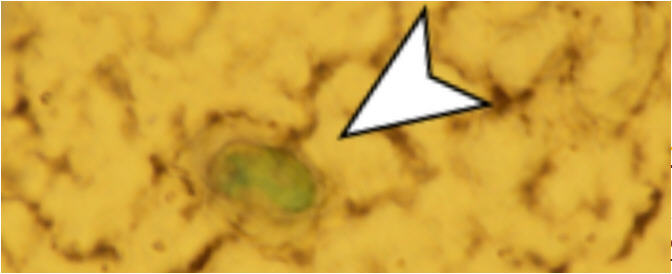博文
一项新研究发现人脑组织中存在微塑料
 精选
精选
||
一项新研究发现人脑组织中存在微塑料
诸平
之前关于“微塑料(Microplastics)”曾经写过几篇博文:如微塑料研究(医学与健康)高引论文(≥200次)、微塑料成为病原体和抗药性细菌的“中心”、科学家首次在血液中发现微塑料、蛋清可以转化为一种过滤海水中微塑料的材料、牛胃中的微生物可以帮助降解回收塑料、体内的微纳塑料是在细胞分裂过程中传递的、首次从植物叶子上的水中发现了微塑料、纳米塑料如何影响新陈代谢、看不见的入侵者: 微塑料是如何潜入你的大脑的?等......今天再来介绍发现人脑组织中存在微塑料。
Microphotograph of nylon found in olfactory bulb tissue. (Amato-Lourenço' et al., JAMA Network Open, 2024)
有关塑料污染的现实(Plastic Pollution Facts)
每年,全球生产的塑料超过4亿吨。超过三分之一的塑料用于包装。1950~2015年间,全球生产了83亿吨塑料。这相当于目前世界人口的人均超过1000 kg。在这83亿吨中,约有30%(25亿吨)仍在使用。从1950~2015年,大约产生了63亿吨塑料垃圾:这个数字包括一次性和再生塑料垃圾。其中约12%(8亿吨)的垃圾被焚烧,9%(6亿吨)被回收利用。在回收的塑料中,只有10%被再次回收。其余79%的塑料垃圾最终被丢弃在垃圾场或被丢弃在环境中。
如果按照目前的速度继续生产,到2050年,垃圾堆上或倾倒在环境中的塑料垃圾将达到约12亿吨。自2000年以来,全球生产的塑料中几乎有一半(44%)投入了市场。在目前生产的所有塑料中,9%被回收(几乎总是导致劣质产品),40%受到控制倾倒,14%受到控制燃烧,32%最终进入环境(这包括不受控制的燃烧)。2018年,欧盟使用了超过1.13万亿件塑料包装。到2025年,全球将生产超过6亿吨塑料。回收系统无法处理这么多的塑料:唯一有帮助的是减少塑料的生产和使用。
令人痛心的是40%的塑料制品在一个月内变成了垃圾。截至2018年,有8600万吨塑料最终流入海洋。其中,0.5%浮在水面上。沿海水域可发现2300万吨(26.8%),海岸搁浅或沉入海底的2900万吨(33.7%),海洋水柱中可发现3400万吨(39%)。在世界自然保护联盟濒危物种红色名录上的120种海洋哺乳动物中,已知有54种会吃塑料或被塑料缠住。北海95%的管鼻鹱(fulmar population)的胃里都有塑料:平均34块(总重量为0.31 g)。在黑尔戈兰岛(islands of Heligoland)95%的塘鹅巢穴(gannet nests)中发现了渔网塑料。在北海的这些岛屿上,三分之一的塘鹅死亡是由缠结引起的:这些鸟在繁殖期间把自己吊在尼龙线上。水中的塑料会吸引诸如多氯联二苯(PCB)和滴滴涕(DDT)等毒素。食用塑料的动物和鸟类也会摄入这些毒素,以及在生产过程中添加到塑料中的有害添加剂。
据了解,至少有387种海洋生物骑着塑料垃圾在水上长途旅行。这导致了新物种入侵对生态系统的干扰。据估计,莱茵河每平方公里向海洋排放893000个微塑料。在世界上所有的大河中,亚洲河流向海洋排放的塑料最多。在许多欧洲国家,污水渣被铺在农田上作为肥料。这样的污水渣充满了从废水中过滤出来的微塑料。2016年法国的微塑料总量为11.653吨!
人脑组织中存在微塑料(New Study Detects Microplastics in Human Brain Tissue)
据《科学警报》(Science Alert)网站2024年9月19日提供的消息,一项新研究发现人脑组织中存在微塑料(New Study Detects Microplastics in Human Brain Tissue)。
我们的微塑料问题(microplastics problem)不会消失。这些塑料污染的微小碎片以前曾出现在我们的肺(our lungs)、古老的岩石(ancient rocks)和瓶装水(bottled water)中。但是,最近的一项新研究揭示了它们对大脑的渗透程度。相关研究结果于2024年9月16日已经在《美国医学会杂志网络公开版》(JAMA Network Open)网站在线发表——Luís Fernando Amato-Lourenço, Katia Cristina Dantas, Gabriel Ribeiro Júnior, Vitor Ribeiro Paes, Rômulo Augusto Ando, Raul de Oliveira Freitas, Ohanna Maria Menezes M. da Costa, Renata S. Rabelo, Kelly Cristina Soares Bispo, Regiani Carvalho-Oliveira, Thais Mauad. Microplastics in the Olfactory Bulb of the Human Brain. JAMA Network Open, 2024, 7(9): e2440018. DOI: 10.1001/jamanetworkopen.2024.40018. Published: September 16, 2024.
参与此项研究的有来自德国柏林自由大学(Freie Universität Berlin, Berlin, Germany)、巴西圣保罗大学(University of São Paulo, São Paulo, Brazil)以及巴西能源与材料研究中心{Brazilian Synchrotron Light Laboratory (LNLS), Brazilian Center for Research in Energy and Materials (CNPEM), São Paulo, Brazil}的研究人员。
这个由德国和巴西科学家组成的团队研究了15名已故者,从鼻子中获取气味信息的脑组织的气味球囊(olfactory bulbs),并在其中8人身上发现了微塑料的存在。
研究人员此前在大脑血块中(in brain blood clots)发现了微塑料,但这是首次发表的在实际脑组织中检测这种材料的研究。另一项类似的研究(similar piece of research)现在正在进行同行评审(peer review)。
研究人员在他们发表的论文中写道(write):“虽然微塑料已经在各种人体组织中被检测到,但它们在人脑中的存在尚未被记录在案,这引发了关于潜在神经毒性作用以及微塑料可能到达脑组织的机制的重要问题。”
研究人员指出,颗粒和纤维是最常见的形状,聚丙烯(polypropylene)是最常见的聚合物:它是应用最广泛的塑料之一,从包装到汽车零部件和医疗设备都可以找到。颗粒大小从5.5 μm到26.4 μm不等,不超过人类头发平均宽度的四分之一。
先前的研究(Previous research)发现,空气污染颗粒通过嗅觉通道进入大脑,而最新的研究表明,微塑料可能通过筛状板(cribriform plate)上的小孔(就在嗅球下方)通过同样的途径进入大脑。
研究人员写道(write):“在鼻子和嗅球中发现的微塑料,以及脆弱的解剖途径,强化了嗅觉途径是外源颗粒进入大脑的重要入口的观点。”
尽管存在所有这些风险和健康影响,但我们似乎无法减少对塑料的依赖。尽管人们一直在努力生产更可生物降解(more biodegradable)的塑料,但事实是,在过去的20年里,塑料的产量翻了一番(doubled in the last 20 years)。
目前尚不清楚的是,这些微塑料会对我们自己的健康造成什么损害,但可以肯定的是,大脑内合成材料浓度的增加并不是什么好消息。根据最近的研究(recent research),神经损伤和神经紊乱的风险增加是可能的。
还需要考虑鼻子的连接。空气污染和认知问题之间的联系已经得到了证实,如果微塑料进入我们的鼻腔,那可能会让事情变得更糟。
研究人员写道(write):“一些神经退行性疾病,如帕金森病(Parkinson's disease),似乎与鼻部异常有关,这是最初的症状。”
本研究由德国亚历山大·冯·洪堡基金会{ Alexander von Humboldt Foundation (AvH), Germany}、塑料汤基金会(Plastic Soup Foundation)、巴西研究委员会{Brazilian Research Council (CNPq) grant 308023/2023-4}以及巴西圣保罗研究局圣保罗研究基金会{Sao State Research Agency (FAPESP) grant 2021/10724-2}资助。
上述介绍,仅供参考。欲了解更多信息,敬请注意浏览原文或者相关报道。
Question Can microplastics reach the olfactory bulb in the human brain?
Findings This case series analyzed the olfactory bulbs of 15 deceased individuals via micro-Fourier transform infrared spectroscopy and detected the presence of microplastics in the olfactory bulbs of 8 individuals. The predominant shapes were particles and fibers, with polypropylene being the most common polymer.
Meaning The presence of microplastics in the human olfactory bulb suggests the olfactory pathway as a potential entry route for microplastics into the brain, highlighting the need for further research on their neurotoxic effects and implications for human health.
Importance Microplastic (MP) pollution is an emerging environmental and health concern. While MPs have been detected in various human tissues, their presence in the human brain has not been documented, raising important questions about potential neurotoxic effects and the mechanisms by which MPs might reach brain tissues.
Objective To determine the presence of MPs in the human olfactory bulb and to analyze their characteristics such as size, morphology, color, and polymeric composition.
Design, Setting, and Participants This case series study used a cross-sectional design involving the analysis of olfactory bulb tissues obtained from deceased individuals during routine coroner autopsies. The sampling procedures were conducted at São Paulo City Death Verification Service, with laboratory analysis carried out at the Brazilian Synchrotron Light Laboratory (LNLS). Participants included 15 adult individuals who had been residents of São Paulo for more than 5 years and underwent coroner autopsies. Exclusion criteria included previous neurosurgical interventions. Data analysis was performed in April 2024.
Exposure The primary exposure assessed was the presence of MPs in the olfactory bulb, analyzed through direct tissue examination and digested tissue filtration followed by micro-Fourier transform infrared spectroscopy.
Main Outcomes and Measures The main outcomes were the identification and characterization of MPs within the olfactory bulb, including their size, morphology, color, and polymeric composition.
Results The median age of the 15 deceased individuals was 69.5 years, ranging from 33 to 100 years, with 12 males and 3 females. MPs were detected in the olfactory bulbs of 8 out of 15 individuals. A total of 16 synthetic polymer particles and fibers were identified, with 75% being particles and 25% being fibers. The most common polymer detected was polypropylene (43.8%). Sizes of MPs ranged from 5.5 μm to 26.4 μm for particles, and the mean fiber length was 21.4 μm. Polymeric materials were absent in procedural blank and negative control filters, indicating minimal contamination risk.
Conclusions and Relevance This case series provides evidence of MPs found in the human olfactory bulb, suggesting a potential pathway for the translocation of MPs to the brain. The findings underscore the need for further research on the health implications of MP exposure, particularly concerning neurotoxicity and the potential for MPs to bypass the blood-brain barrier.
https://blog.sciencenet.cn/blog-212210-1451929.html
上一篇:2024年引文桂冠奖揭晓
下一篇:人类基因组存储在“永久”记忆晶体上
